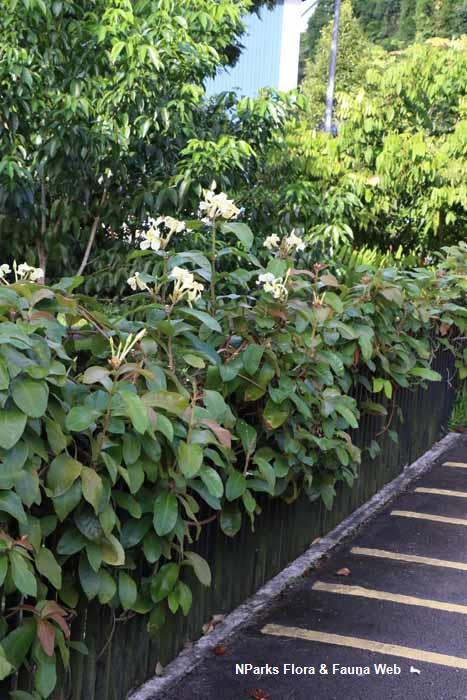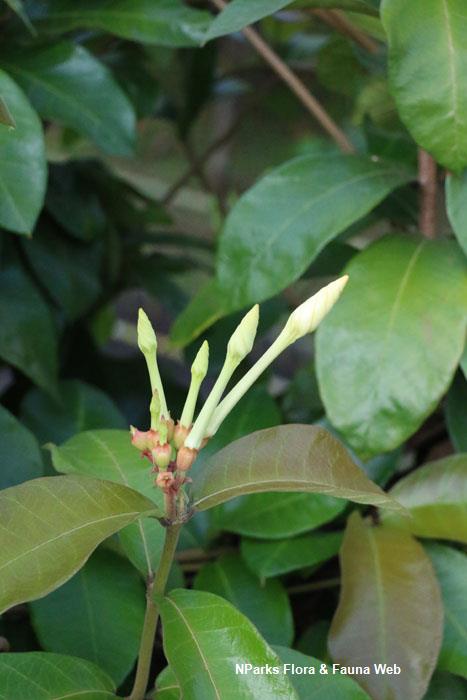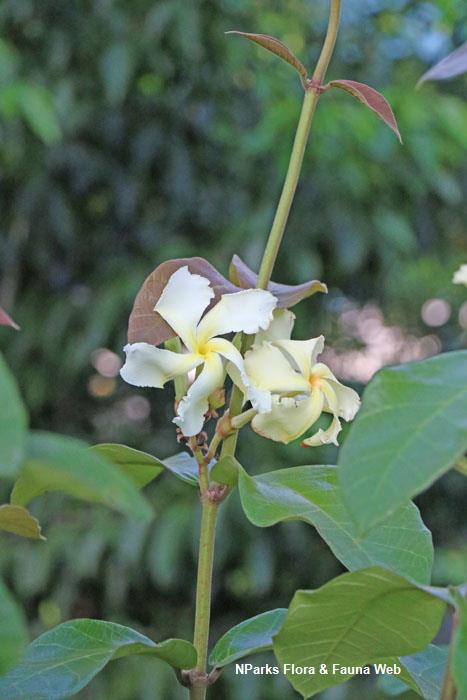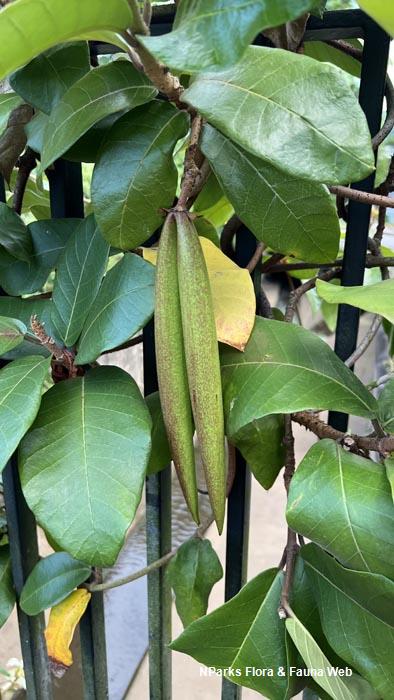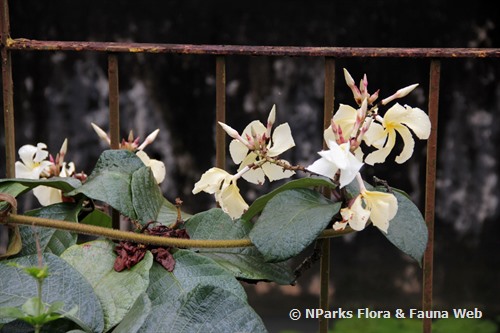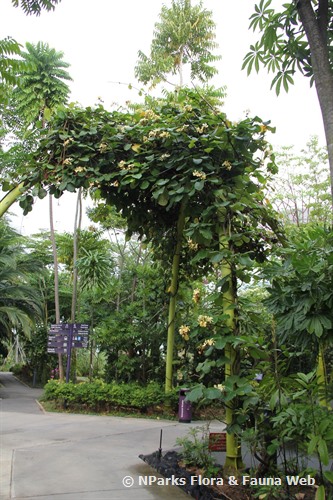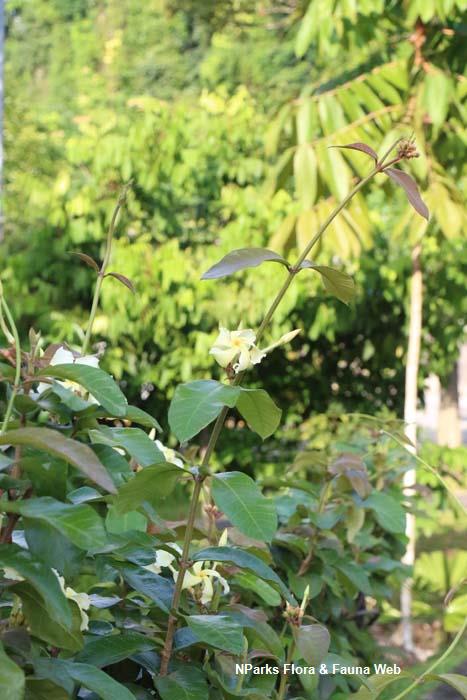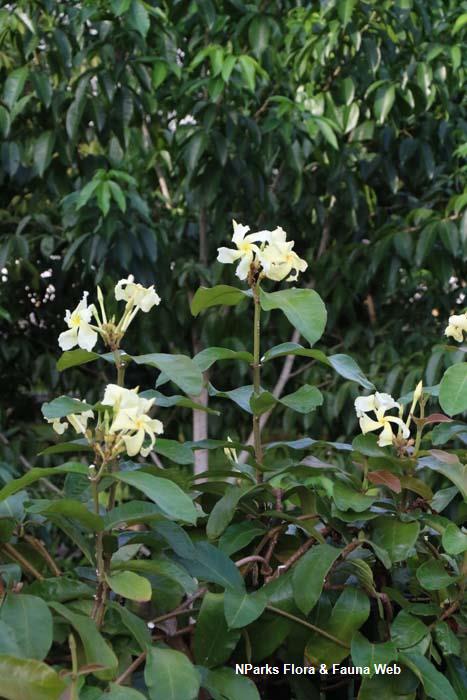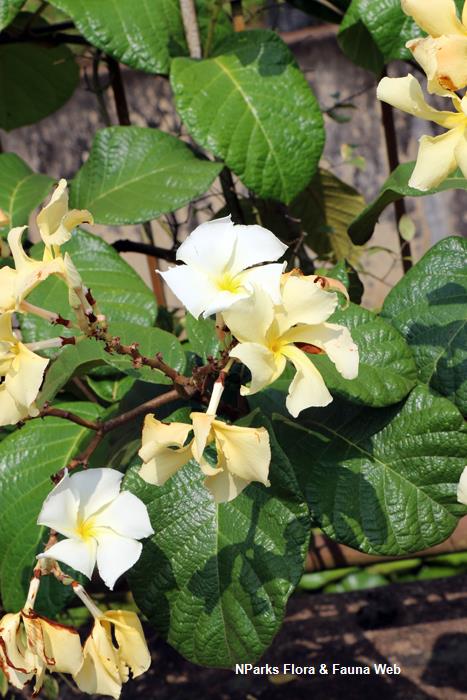
Back
Chonemorpha fragrans (Moon) Alston
| Family Name: | Apocynaceae |
| Synonyms: | Chonemorpha macrophylla G. Don, Chonemorpha penangensis Ridl., Chonemorpha elliptica Merr. & Rolfe, Chonemorpha grandieriana Pierre ex Spire, Chonemorpha macrantha Pit. |
| Common Name: | Frangipani Vine, Akar Gerip Merah, Akar Gerit-Gerit Merah, Akar Gerit Merah, 大叶鹿角藤 |
Chonemorpha fragrans (Frangipani Vine) is a native climber with sweetly-scented flowers and large oval leaves. While the showy, creamy-white flowers bear some resemblance to the Frangipani (Plumeria obtusa), this species is not a tree but a woody climber that can grow up to 20 m! It grows well with support such as on pergolas and adds a luxurious, tropical feel to gardens.
Name
Classifications and Characteristics
| Plant Division | Angiosperms (Flowering Seed Plants) (Dicotyledon) |
|---|---|
| Plant Growth Form | Climber |
| Lifespan (in Singapore) | Perennial |
| Mode of Nutrition | Autotrophic |
| Plant Shape | Irregular |
| Chromosome Number | 20 |
| Maximum Height | 20 m |
Biogeography
| Native Distribution | Himalaya to Western and Central Malesia. |
|---|---|
| Native Habitat | Terrestrial (Primary Rainforest, Secondary Rainforest, Monsoon Forest) |
| Preferred Climate Zone | Tropical, Sub-Tropical / Monsoonal |
| Local Conservation Status | Native to Singapore (Critically Endangered (CR)) |
Description and Ethnobotany
| Growth Form | It is a latex-containing climber or liana up to 20 m long, its branchlets are sparsely to densely covered with hair, and lenticillate. |
|---|---|
| Foliage | Its latex-containing, opposite, stalked leaves have leathery leaf blades that are round, oval or drop-shaped with a rounded or pointed tip and a heart-shaped to narrowed base, 4–38 by 2.8–35 cm, and densely covered with hair. |
| Flowers | Its fragrant, tubular flowers are cream or white, 1.8–6.5 by 4.2–13 cm, hairless or hairy, and are arranged in many-flowered, 10–30 cm long clusters at the ends of branches. |
| Fruit | Its fruits are spindle-shaped, flattened, hairless or hairy, and 18–40 by 1–2.3 cm. |
| Habitat | It grows in lowland forests, scrub habitats and karst limestone. It occurs in Nee Soon Swamp Forest, and in the vicinity of Upper Seletar Reservoir. |
| Associated Fauna | Its flowers are insect-pollinated. |
| Cultivation | It may be suitable for parks. It can be propagated by seed. Plant requires support. |
| Etymology | Greek chone, a funnel; Greek morphe, form, referring to the shape of the corolla; Latin fragrans, referring to the fragrant flowers. |
| Ethnobotanical Uses | Cultural / Religious: The sweet-scented flowers are given to guests at weddings, and Malay women wear the flowers in their hair. Others: The white latex can be used as rubber. The plant’s bark is scraped to obtain fibre which is said to be very durable in both fresh and salt water. However, the bark and leaves of this plant are poisonous. |
Landscaping Features
| Landscaping | Suitable for pergolas and on strong support system, for its ornamental and fragrant flowers. |
|---|---|
| Desirable Plant Features | Ornamental Flowers, Fragrant (Flowers) |
| Landscape Uses | Parks & Gardens, Trellis / Arbour / Pergola |
| Thematic Landscaping | Fragrant / Aromatherapy Garden |
| Usage Hazard - Cons | Toxic Upon Ingestion, Irritant - Sap |
Fauna, Pollination and Dispersal
| Fauna Pollination Dispersal Associated Fauna | Butterfly-Attracting, Bird-Attracting |
|---|
Plant Care and Propagation
| Light Preference | Full Sun, Semi-Shade |
|---|---|
| Water Preference | Moderate Water |
| Plant Growth Rate | Moderate |
| Rootzone Tolerance | Moist Soils, Well-Drained Soils |
| Propagation Method | Seed |
Foliar
| Foliage Retention | Drought / Semi-Deciduous |
|---|---|
| Mature Foliage Colour(s) | Green |
| Mature Foliage Texture(s) | Hairy / Hirsute, Leathery |
| Prominent Young Flush Colour(s) | Green |
| Young Flush Texture(s) | Hairy / Hirsute |
| Foliar Modification | Trichome / Hair |
| Foliar Type | Simple / Unifoliate |
| Foliar Arrangement Along Stem | Opposite |
| Foliar Attachment to Stem | Petiolate |
| Foliar Shape(s) | Non-Palm Foliage (Ovate) |
| Foliar Venation | Pinnate / Net |
| Foliar Margin | Entire |
| Foliar Apex - Tip | Mucronate |
| Foliar Base | Cordate |
Non - Foliar and Storage
| Stem Type & Modification | Woody |
|---|---|
| Root Type | Underground |
Floral (Angiosperm)
| Flower & Plant Sexuality | Bisexual Flowers |
| Flower Colour(s) | Cream / Off-White, White |
|---|---|
| Flower Texture(s) | Waxy |
| Flower Grouping | Cluster / Inflorescence |
| Flower Location | Terminal |
| Flower Symmetry | Radial |
| Individual Flower Shape | Funnelform / Funnel-shaped |
| Inflorescence Type | Cyme |
| Flowering Period | Free-Flowering |
| Flowering Opening Time | Daytime |
Image Repository
Others
| Master ID | 29504 |
|---|---|
| Species ID | 3813 |
| Flora Disclaimer | The information in this website has been compiled from reliable sources, such as reference works on medicinal plants. It is not a substitute for medical advice or treatment and NParks does not purport to provide any medical advice. Readers should always consult his/her physician before using or consuming a plant for medicinal purposes. |

